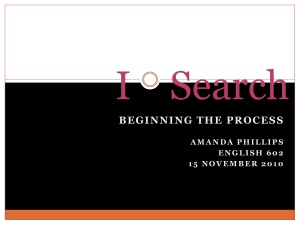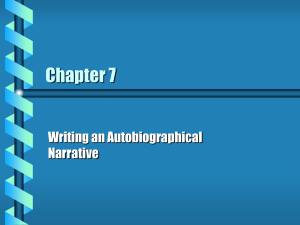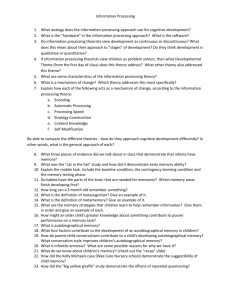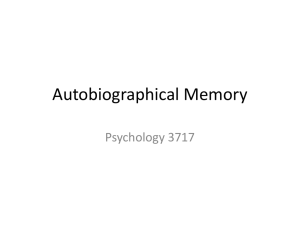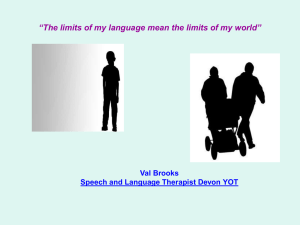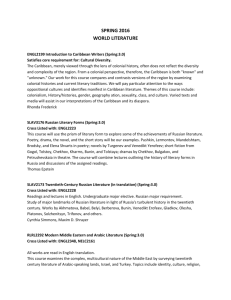New questioning strategies to early Russian autobiographies
advertisement
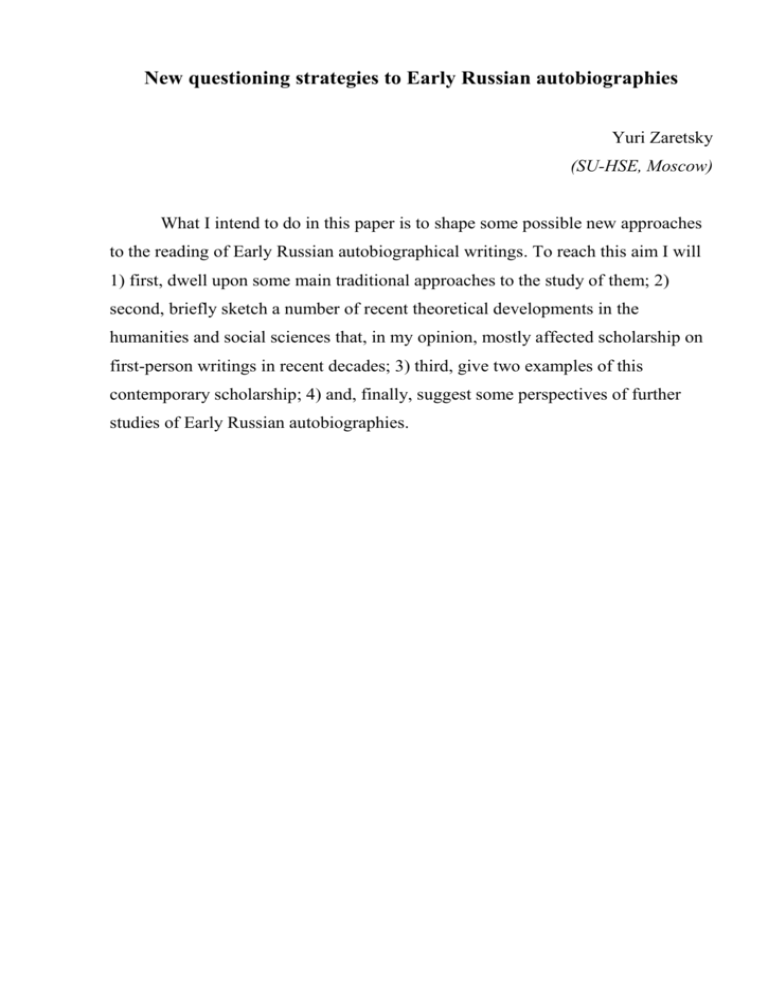
New questioning strategies to Early Russian autobiographies Yuri Zaretsky (SU-HSE, Moscow) What I intend to do in this paper is to shape some possible new approaches to the reading of Early Russian autobiographical writings. To reach this aim I will 1) first, dwell upon some main traditional approaches to the study of them; 2) second, briefly sketch a number of recent theoretical developments in the humanities and social sciences that, in my opinion, mostly affected scholarship on first-person writings in recent decades; 3) third, give two examples of this contemporary scholarship; 4) and, finally, suggest some perspectives of further studies of Early Russian autobiographies. 2 I. Though the practice of labeling some of Early Russian writings as autobiographies had originated more than a century ago,1 distinction and separation of autobiography as a specific group in the body of Russian culture began only in late 1950s. The dominant interpretation strategy has been shaped by scholars who treated “autobiography” as a specific constituent part of Old Russian literature, though some paid considerable attention to “historical reality,” i.e. to connections of autobiographical texts with concrete social, cultural, religious, and political circumstances. The main attention in this scholarship is paid to such quests as genre attribution (autobiography or not); to uncovering principles of composition (or “authorial design” – avtorskij zamysel); to detecting of narrative structure (constituent parts, episodes and the ways they are connected to each other) and narrative order (chronological, thematic or mixed); to literary/hagiographical clichés used by authors; and to specific features contributing to integrity of the texts (tselostnost' proizvedenija). This scholarship is mostly concerned with the issue of genre2. What is the place of “autobiography” in the structure of genres of the Old Russian literature? Is it possible to identify autobiography (or more delicately “autobiographical tradition”) in it? If yes, where this tradition starts from and what text should be considered “the first Russian autobiography”? Literary historians have also approached the Early Russian autobiographical writings from the aesthetical perspective, in particular by discussing such their Exclusively referring to Avvakum’s Life – see Alexandr Pypin, Istorija russkoj literatury [A history of Russian literature] 2 (Saint-Petersburg, 1898), p. 315. It should be noted that the brief overview below does not cover textual criticism. 2 See recently: Andrej Ranchin, “Avtobiograficheskie povestvovanija v russkoj literature vtoroi poloviny XVI-XVII vv.: problema zhanra [Autobiographical narratives in Russian literature of the second half of sixteenth – seventeenth centuries: the genre problem],” Idem, Statji o drevnerusskoj literature [Articles on Old Russian literature] (Мoscow, 1999), pp. 158-177. 1 2 3 characteristics as poetics and style. In their studies, these characteristics are most often viewed as means by which authors managed to create works of certain artistic value (khudozhestvennaja tsennost'). In accordance with this approach, the autobiographical text is treated as a product of the “creative literary work” (literaturnoe tvorchestvo) of its author and, correspondingly, a source for the reconstruction of authorial design (avtorskij zamysel), of artistic design (khudozhestvennyj zamysel) and of artistic devices authors used (khudozhestvennye priemy). The ultimate aim of this type of studies is to uncover peculiarities of the “artistic nature” (khudozhestvennaja priroda) of this or that autobiographical writing, and to portray autobiographism as a “certain set of literary means for representation of human life and human inner world.”3 What is common for all the approaches of literary historians and critics sketched above, is efforts to trace continuities, i.e. to uncover what they call “the ways of formation and development” of autobiography and its “genetic connections.”4 Besides literary historians and critics, autobiographical writings have attracted substantial attention of historians of culture and religion, and, in some measure, of political historians of pre-modern Russia. This group of scholars mostly used first person narratives as sources for biographical studies of concrete historical figures, especially in cases when other documentary data on their lives was not accessible. Generally, most studies that practice this kind of approach take an autobiographical story as a documentary record not only of biographical and political facts, but also of such “realities” as author’s unique personality or his Andrej Robinson, “Zhitie Epifanija kak pamjatnik didakticheskoi avtobiografii [Epifanij’s Life as a record of didactic autobiography],” Trudy Otdela drevnerusskoj literatury 15 (MoscowLeningrad, 1958), p. 205. 4 Kopreeva, K voprosu o zhanrovoj prirode ‘Pouchenija’, pp. 102–104, 107. 3 3 4 “inner self” (vnutrennee ‘ja’)5. Correspondingly, these studies are mostly directed at portraying this unique personality and its development, at describing the author/hero’s individual feelings and emotions, his psychological collisions, his mental turmoil, etc. The above-mentioned approaches have a number of common characteristics that are rooted in some fundamental conventions of European nineteenth- and twentieth-century scholarship. Two of these conventions are most vivid: a) understanding of the relationship between text and reality in the way that every autobiographical writing represents the “objective world” and b) understanding of the author of an autobiographical text as a concrete “historical figure” who generates all meanings of his writing. Such understandings dictate the task of deciphering an autobiographical text in order to uncover its author’s inner world (vnutrennij mir), or less ambitiously, his ideology (idejnaja pozitsija avtora) imprinted in the writing. From two other fundamental conventions of this scholarship –general vision of the past as a progressive continuity (the earlier textual forms have gradually transformed into modern ones) and understanding the progress of human history as a progress of individualism (development of “autobiographical forms” indicates this progress and vice versa) – comes out a view “from above,” aimed at considering the first Russian autobiography as the first manifestation of the individualistic self in Russian culture. Kopreeva, K voprosu o zhanrovoj prirode ‘Pouchenija’, pp. 94-98, 102. See also Krushel’nitskaja, Avtobiografija i zhitie, p. 164: “authorial inner source” (avtorskoe lichnostnoe nachalo), “authorial self” (avtorskoe “ja”). 5 4 5 II. Recent theoretical developments in humanities and social sciences suggest a variety of new approaches to the studies of pre-modern autobiographical texts. Some of these approaches have considerably influenced the reading of Early Western self-narratives (German, French, Dutch and others). Three of them are briefly outlined below. 1. Probably the most significant of the three is social constructionism (or social constructivism)6. According to this approach, various basic concepts and notions that seemed firm and obvious, as if directly coming from Nature or from historical reality (state, nation, madness, the Orient, Europe, the self, etc.), in fact are flexible, historically changeable constructions of a given society and culture. In other words, they are not “objective” categories but variable by-products of the interplay of different social forces and the outcome (“inventions” or “artifacts”) of different human activities. The gaining power of constructionism resulted in undermining the very basics of the traditional model of what is called “the history of subjectivity” or “the history of the self.”7 The key constitutive element of this model, the concept of integral human self as a part of reality and a producer of evidences about itself, has little by little lost its incontrovertibility and has been replaced by other concepts and frames8. The very notions of the self, individual, and person have been often substituted by an even more ambiguous notion of the “subject,” generally understood as something that is “produced” or “made.” According to this perspective it is not the subject that produces discourses but in reverse, it is socially and culturally established discourses that produce the subject. As Joan Scott formulates this turnover view on the subjectivity with 6 On constructionism and deconstructionism in history see: The Nature of History Reader, ed. Keith Jenkins and Alun Munslow (London - New York, 2004), pp. 61-240. 7 See as an example: http://www.historians.org/annual/2003/AHA2.HTM 8 Reconstructing Individualism: Autonomy, Individuality and the Self in Western Thought, ed. Thomas C. Heller, Morton Sosna, and David E. Wellbery (Stanford, 1986); Rewriting the Self: Histories from the Middle Ages to Present, ed. Roy Porter (London, 1997). 5 6 regard to the notion of “experience”: “being a subject means being subject to definite conditions of existence, conditions of endowment of agents and conditions of exercise.”9 The constructionist approach to the notion of the subject and, correspondingly, to the “history of subjectivity” has made a strong impact on autobiographical studies, in particular on the attempts of working out new visions of the history of autobiography. The second shift that strongly affected autobiographical studies – parallel and in many ways linked to constructionism – is the so-called linguistic turn.10 If “‘things’ as such have no social reality apart from their linguistic construction,” if “they are not objective givens in themselves, but rather a product of a linguistic process of ‘objectification,’”11 then this is also true for such “reality” as the individual self. Correspondingly, autobiographical texts are, first and foremost, evidences of how this “reality” is “objectified” in language and speech. Influenced by these language limitations, many recent historical studies of autobiographical writings drifted far away from the traditional readings that approached them as “sources” created to inform us about the “real” self of a “real” person (the Author). Instead of trying to reach directly this “real” self, scholars turned to uncovering specific textual conventions that produce this or that model of the self, to discussing its peculiarities and its connection to a certain group of texts or culture, to practicing narratological analysis12, etc. Finally, the third shift that is tightly intertwined with the two mentioned above, is associated with anthropological turn (or cultural turn). This shift has been set in about half a century ago, after a large group of historians had become Joan W. Scott, “The Evidence of Experience,” Critical Inquiry 17 (1991): 793. The notion has been coined by theorist Richard Rorty: The linguistic turn; recent essays in philosophical method, ed. Richard Rorty (Chicago, 1967). 11 Idem, p. 5. 12 Among the earliest studies of this kind: Evelyn B. Vitz, Medieval Narrative and Modern Narratology: Subjects and Objects of Desire (New York, 1989). 9 10 6 7 aware of the importance of anthropologically interpreted concept of culture for understanding a given society. Cultural historians made emphasis on the study of the singularity of a given culture and thus supported the idea of discontinuity in cultural developments. From such view on the human past, it follows that the concept of the self elaborated in European scholarship as universal should be treated as “narrow,” i.e. as one of many possible. Consequently, it follows that it is wrong to try and apply this concept to autobiographical texts that originated in other cultures, because the practice of such application faultily pictures any non-Western autobiography and the self as “underdeveloped.” In very general terms, the main impact of anthropological/cultural turn on the historical study of autobiographical writings may be reduced to one straightforward argument: the very notions of “autobiography” and the “self” should be approached not as universal categories but as specific phenomena imbedded in a given culture and shaped by its “codes.” 7 8 III. Not a few scholars of autobiography in the last decades either opposed the aforementioned challenges as alien to the humanistic notion of the self (understood as the basis for autobiographical research), or ignored them as useless for empirical studies. Nevertheless, some of these challenges have substantially influenced approaches to pre-modern and early modern autobiographical writings. Among examples of this influence I would first mention the research program that has been launched about ten years ago by the group Self-Narratives in Transcultural Perspective of the Department of History and Cultural Studies at the Free University in Berlin (directed by Gabriele Jancke and Claudia Ulbrich)13. The group combines efforts of scholars from a variety of disciplines who study both Western and non-Western self-narratives mostly belonging to the Early Modern period. The major subject of its studies is defined as “writings about the author’s own life that hold to specific narrative conventions.”14 Contrary to the widely accepted view on autobiography as a specifically western genre tightly bounded with the idea of individual self that emerged in Europe as a by-product of modernization, the group aims at analyzing selfnarratives “in the light of new questions and new methodologies.”15 The core of this new perspective constitutes refusal from the dominant Eurocentric view on the development of self-testimonies in other cultures and “approaches to these source materials that take as their analytical focus the writing subject as active agent in the context of her or his own social and cultural relations.”16 The project Controlling Time and Shaping the Self: Education, Introspection and Practices of Writing in the Netherlands 1750-1914 at the Faculty of History 13 URL: http://www.fu-berlin.de/dfg-fg/fg530/en/index.html Ibid. The major term used is “Selbstzeugnisse,” translated into English as “self-narratives.” 15 Ibid. 16 Ibid. 14 8 9 and Arts of the University of Rotterdam (directed by Arianne Baggerman)17 may be taken as the second example of new approaches in autobiographical studies practiced by historians. This project is mostly aimed at working out a new paradigm of the developments of the late 18th – early 20th century egodocuments18 in the Netherlands (and tentatively in Western Europe as a whole) and to suggest new methodologies of their investigations. Traditionally, claims Arianne Baggerman, the rise of production of egodocuments in the nineteenth century has been correlated with the growing introspection and self-questioning in European culture, though such observation “was based on a limited canon of great writers, including Rousseau and Goethe.”19 The recently undertaken studies of Dutch egodocuments written between 1814 and 1914 en masse strongly challenge the traditionally accepted perspective. “Contrary to expectations, -- observes Baggerman, -- the number of factual diaries and impersonal memoirs rose more sharply than the number of intimate introspective texts.”20 To explain this discovery and to construct a new vision of the development of egodocuments in the “long nineteenth century,” she suggests using Reinhart Koselleck’s hypothesis of unprecedented turnover in the perception of temporality that took place in Europe around mid-eighteenth century21. According to Koselleck, this shift resulted in the emergence of new strategies of human behaviour, such as the attempts “to master temporality” and to control individual experiences. Thus, the key task of Baggerman’s project is to investigate “to what extent and in what ways, the specific contents and forms of egodocuments, as well 17 http://www.egodocument.net/Arianne.htm The term “egodocument” is used here in a sense common for contemporary Dutch historiography (see: Rudolf M. Dekker, “Jacques Presser’s heritage. Egodocuments in the study of history,” Memoria y Civilización. Anuario de Historia 5 (2002): 13-37. 19 http://www.egodocument.net/Arianne.htm 20 Ibid. 21 See: Reinhart Koselleck, Vergangene Zukunft. Zur Semantik geschichtlicher Zeiten (Frankfurt am Main, 1979). 18 9 10 as the increase in their number in the long nineteenth century were related to the emergence of a new sense of temporality.”22 22 http://www.egodocument.net/Arianne.htm 10 11 IV. Turning finally back to the point, it may be suggested that the recent insights of historians and literary scholars in the studies of autobiographies may have considerable implications for the reading of Old Russian autobiographical texts. It is very likely that they might constitute a meaningful background for further questioning or even requestioning these texts. Four directions for such requestioning are proposed below. 1. Refusal of the holistic approach. Varieties of forms, contents, social and historical contexts and audiences of Old Russian autobiographical texts suggest that they barely allow asking unified questions, and thus could be more effectively approached not as an isolated semantic unity proposed by the very notion of autobiography but in some other ways. First of all, as it is only our modern “individualistic” perspective that makes these texts “autobiographical” but not “theirs,” to avoid anachronistic misunderstanding these texts need to be contextualized historically. They should be linked with other texts and writing practices of their times and framed in view of these texts and practices. 2. Tracing the patterns of early Russian autobiographical discourse and their historical changes. At the same time, as the texts under discussion have such common formal characteristics as narration from the first-person singular and telling a life-story of the speaker, they might be also regarded as a certain semantic unity. In particular, they seem to be informative about specific modes and patterns of Old Russian autobiographical discourse, about historical development of these modes and patterns, about continuities and discontinuities between them, about their relation to major developments of early Russian culture, about parallels with Western European and Byzantine models, etc. 3. Grouping and reading. The texts commonly called Old Russian autobiographies might be more easily grouped together on the basis of similarity of their social origin than of their attribution to a certain literary genre. On the whole, it seems that these texts might become more informative about early Russian 11 12 culture if read as a part of social and cultural practices23 than as a part of literary process and genre development. 4. Studying in comparative perspective. Epistemological difficulties in making historical comparisons24, despite being theoretically and logically persuasive, do not eliminate our eagerness for comparisons. In our case, a general frame for comparative study may be provided by the fact that early Russian autobiographical writings belong to the Medieval Christian tradition and may be approached in parallel with Western and Eastern (Byzantine) as a constituent part of it. 23 Gabriele Jancke, Autobiographie als soziale Praxis. Beziehungskonzepte in Selbstzeugnissen des 15. und 16. Jahrhunderts im deutschsprachigen Raum (Cologne-Weimar-Vienna, 2002). 24 Comparative history has been harshly questioned in the last decades, which allows making strong discouraging statements. See for example: Donald Kelley, “Grounds for comparison,” 19th International Congress of Historical Sciences (Oslo, 2000), pp. 6-13 – http://www.oslo2000.uio.no/program/papers/r3/r3-kelley.pdf . 12
